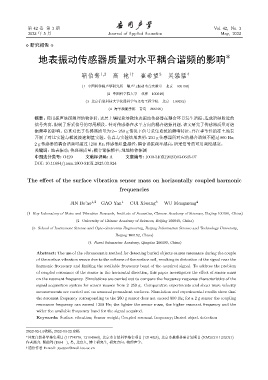Page 207 - 《应用声学》2023年第3期
P. 207
第 42 卷 第 3 期 Vol. 42, No. 3
2023 年 5 月 Journal of Applied Acoustics May, 2023
⋄ 研究报告 ⋄
地表振动传感器质量对水平耦合谐频的影响 ∗
靳伯骜 1,2 高 艳 1† 崔希望 3 吴猛猛 4
(1 中国科学院声学研究所 噪声与振动重点实验室 北京 100190)
(2 中国科学院大学 北京 100049)
(3 北京信息科技大学仪器科学与光电工程学院 北京 100192)
(4 海军潜艇学院 青岛 266199)
摘要:使用振声法探测埋地物体时,表层土壤松软导致地表振动传感器在耦合环节发生谐振,造成谐频附近的
信号失真,限制了所采信号的可用频段。针对传感器在水平方向的耦合谐振问题,该文研究了传感器质量对谐
振频率的影响。仿真对比了传感器质量为 2∼ 250 g 情况下信号采集系统的频响特征,并在季节性的冻土地表
开展了对比实验与横波波速测量实验。仿真与实验结果表明:250 g 传感器所对应的耦合谐频不超过 800 Hz;
2 g 传感器的耦合谐频可超过 1200 Hz;传感器质量越轻,耦合谐振频率越高,所采信号的可用频段越宽。
关键词:地表振动;传感器质量;耦合谐振频率;埋地物体探测
中图法分类号: O429 文献标识码: A 文章编号: 1000-310X(2023)03-0645-07
DOI: 10.11684/j.issn.1000-310X.2023.03.024
The effect of the surface vibration sensor mass on horizontally coupled harmonic
frequencies
JIN Bo’ao 1,2 GAO Yan 1 CUI Xiwang 3 WU Mengmeng 4
(1 Key Laboratory of Noise and Vibration Research, Institute of Acoustics, Chinese Academy of Sciences, Beijing 100190, China)
(2 University of Chinese Academy of Sciences, Beijing 100049, China)
(3 School of Instrument Science and Opto-electronics Engineering, Beijing Information Science and Technology University,
Beijing 100192, China)
(4 Naval Submarine Academy, Qingdao 266199, China)
Abstract: The use of the vibroacoustic method for detecting buried objects causes resonance during the couple
of the surface vibration sensor due to the softness of the surface soil, resulting in distortion of the signal near the
harmonic frequency and limiting the available frequency band of the acquired signal. To address the problem
of coupled resonance of the sensor in the horizontal direction, this paper investigates the effect of sensor mass
on the resonant frequency. Simulations are carried out to compare the frequency response characteristics of the
signal acquisition system for sensor masses from 2–250 g. Comparative experiments and shear wave velocity
measurements are carried out on seasonal permafrost surfaces. Simulation and experimental results show that
the resonant frequency corresponding to the 250 g sensor does not exceed 800 Hz; for a 2 g sensor the coupling
resonance frequency can exceed 1200 Hz; the lighter the sensor mass, the higher resonant frequency and the
wider the available frequency band for the signal acquired.
Keywords: Surface vibration; Sensor weight; Coupled resonant frequency; Buried object detection
2022-02-14 收稿; 2022-04-22 定稿
国家自然科学基金项目 (11774378, 12104060), 北京市自然科学基金项目 (1214025), 北京市教委科研计划项目 (KM202111232021)
∗
作者简介: 靳伯骜 (1994– ), 男, 北京人, 博士研究生, 研究方向: 物理声学。
† 通信作者 E-mail: gaoyan@mail.ioa.ac.cn

